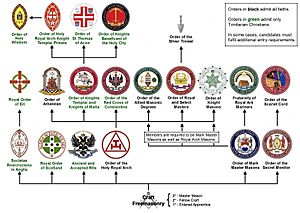Mark Masons' Hall, London facts for kids
Mark Masons' Hall is a special building in London, England. It's like the main office for a group called the Grand Lodge of Mark Master Masons of England and Wales. This group is part of Freemasonry, which is one of the oldest social and charitable organizations in the world. Mark Masons' Hall is also home to many other important Masonic groups in England and Wales. You can find it at 86 St James's Street in central London, right across from St James's Palace.
Contents
History of Mark Masons' Hall
Early Buildings on the Site
The spot where Mark Masons' Hall stands today has a long history. Since the early 1700s, it has been home to different public places. First, it was Williams' Coffee-House in 1702, a popular spot for writers and thinkers. Later, it became a tavern and then a coffee house again, also serving as a private club.
One club, called Atwood's, started here in 1772. A famous historian and Freemason named Edward Gibbon was a member. In 1785, the building burned down but was rebuilt the next year. By 1801, it was a public house where people played billiards. After a few more changes, the building was knocked down in 1862 to make way for a new one.
The Current Building
The building you see today at 86 St James's Street was built between 1862 and 1865. It was designed by Sir James Thomas Knowles (1831-1908). For many years, it was used by different private clubs, like the Civil Service Club and the Thatched House Club.
In 1977, the Grand Lodge of Mark Master Masons took over the building. They spent about a year making changes to it. Mark Masons' Hall officially opened its doors on September 1, 1979.
What Mark Masons' Hall Looks Like
Mark Masons' Hall is a special building that is protected as a Grade II listed building. This means it's an important historical building. It has seven levels, including a lower ground floor and a basement.
The front of the building has four arched sections on the ground floor. The main entrance is a double doorway at the top of some stone steps. The windows on the first and third floors are also arched. On the very top floor, there are four stone dormer windows. The roof is steep and has two tall chimneys on each side.
Inside, the main entrance leads to a fancy hall with wood panels. There's a beautiful stone staircase with a decorative iron railing.
Rooms Inside the Hall
On the ground floor, there are three large rooms. Two of these are used as Masonic temples, which are special meeting rooms for Masonic groups. The third room is a Board Room.
The first floor has a dining room at the front, which has a nice view of St James's Street and St James's Palace. Other areas on this floor are also used for dining and meetings. On the second floor, you'll find a bar and two more Masonic temples. The third floor has three more dining rooms and two more Masonic temples. The offices are located on the fourth floor.
All seven Masonic temples were officially opened on September 30, 1980. They have unique names like Grand Temple, Brazil, Bristol, Hong Kong, River Plate, Warwickshire, and Johann Gutenberg.
Headquarters for Masonic Groups
Mark Masons' Hall is the main office for many different Masonic groups in England and Wales. These groups are often called "appendant orders" because they are connected to the main Freemasonry organization.
Some of the groups that have their headquarters here include:
- Order of Mark Master Masons
- Order of Royal Ark Mariners
- Order of the Secret Monitor
- Order of the Scarlet Cord
- Allied Masonic Degrees
- Knights Templar and Knights of Malta
- Order of Royal and Select Masters
- Rectified Scottish Rite
- Red Cross of Constantine
Mark Masons' Hall also helps manage the Royal Order of Scotland for London. There are also two councils of the Order of Knight Masons that meet in the building. Another group, called Ye Antient Order of Noble Corks, has a connection to Mark Masons' Hall. This is a fun, informal group that raises money for charity.


